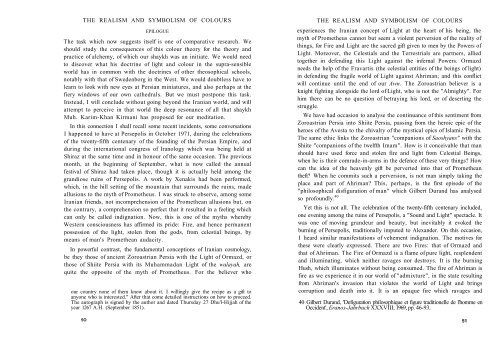Temple and Contemplation brings together for the first ... - ImagoMundi
Temple and Contemplation brings together for the first ... - ImagoMundi
Temple and Contemplation brings together for the first ... - ImagoMundi
Create successful ePaper yourself
Turn your PDF publications into a flip-book with our unique Google optimized e-Paper software.
THE REALISM AND SYMBOLISM OF COLOURS<br />
EPILOGUE<br />
The task which now suggests itself is one of comparative research. We<br />
should study <strong>the</strong> consequences of this colour <strong>the</strong>ory <strong>for</strong> <strong>the</strong> <strong>the</strong>ory <strong>and</strong><br />
practice of alchemy, of which our shaykh was an initiate. We would need<br />
to discover what his doctrine of light <strong>and</strong> colour in <strong>the</strong> supra-sensible<br />
world has in common with <strong>the</strong> doctrines of o<strong>the</strong>r <strong>the</strong>osophical schools,<br />
notably with that of Swedenborg in <strong>the</strong> West. We would doubtless have to<br />
learn to look with new eyes at Persian miniatures, <strong>and</strong> also perhaps at <strong>the</strong><br />
fiery windows of our own ca<strong>the</strong>drals. But we must postpone this task.<br />
Instead, I will conclude without going beyond <strong>the</strong> Iranian world, <strong>and</strong> will<br />
attempt to perceive in that world <strong>the</strong> deep resonance of all that shaykh<br />
Muh. Karim-Khan Kirmani has proposed <strong>for</strong> our meditation.<br />
In this connection I shall recall some recent incidents, some conversations<br />
I happened to have at Persepolis in October 1971, during <strong>the</strong> celebrations<br />
of <strong>the</strong> twenty-fifth centenary of <strong>the</strong> founding of <strong>the</strong> Persian Empire, <strong>and</strong><br />
during <strong>the</strong> international congress of Iranology which was being held at<br />
Shiraz at <strong>the</strong> same time <strong>and</strong> in honour of <strong>the</strong> same occasion. The previous<br />
month, at <strong>the</strong> beginning of September, what is now called <strong>the</strong> annual<br />
festival of Shiraz had taken place, though it is actually held among <strong>the</strong><br />
gr<strong>and</strong>iose ruins of Persepolis. A work by Xenakis had been per<strong>for</strong>med,<br />
which, in <strong>the</strong> hill setting of <strong>the</strong> mountain that surrounds <strong>the</strong> ruins, made<br />
allusions to <strong>the</strong> myth of Prome<strong>the</strong>us. I was struck to observe, among some<br />
Iranian friends, not incomprehension of <strong>the</strong> Prome<strong>the</strong>an allusions but, on<br />
<strong>the</strong> contrary, a comprehension so perfect that it resulted in a feeling which<br />
can only be called indignation. Now, this is one of <strong>the</strong> myths whereby<br />
Western consciousness has affirmed its pride: Fire, <strong>and</strong> hence permanent<br />
possession of <strong>the</strong> light, stolen from <strong>the</strong> gods, from celestial beings, by<br />
means of man's Prome<strong>the</strong>an audacity.<br />
In powerful contrast, <strong>the</strong> fundamental conceptions of Iranian cosmology,<br />
be <strong>the</strong>y those of ancient Zoroastrian Persia with <strong>the</strong> Light of Ormazd, or<br />
those of Shiite Persia with its Muhammadan Light of <strong>the</strong> walayah, are<br />
quite <strong>the</strong> opposite of <strong>the</strong> myth of Prome<strong>the</strong>us. For <strong>the</strong> believer who<br />
our country none of <strong>the</strong>m know about it. I willingly give <strong>the</strong> recipe as a gift to<br />
anyone who is interested." After that come detailed instructions on how to proceed.<br />
The autograph is signed by <strong>the</strong> author <strong>and</strong> dated Thursday 27 Dhu'l-Hijjah of <strong>the</strong><br />
year 1267 A.H. (September 1851).<br />
5O<br />
THE REALISM AND SYMBOLISM OF COLOURS<br />
experiences <strong>the</strong> Iranian concept of Light at <strong>the</strong> heart of his being, <strong>the</strong><br />
myth of Prome<strong>the</strong>us cannot but seem a violent perversion of <strong>the</strong> reality of<br />
things, <strong>for</strong> Fire <strong>and</strong> Light are <strong>the</strong> sacred gift given to men by <strong>the</strong> Powers of<br />
Light. Moreover, <strong>the</strong> Celestials <strong>and</strong> <strong>the</strong> Terrestrials are partners, allied<br />
<strong>toge<strong>the</strong>r</strong> in defending this Light against <strong>the</strong> infernal Powers. Ormazd<br />
needs <strong>the</strong> help of <strong>the</strong> Fravartis (<strong>the</strong> celestial entities of <strong>the</strong> beings of light)<br />
in defending <strong>the</strong> fragile world of Light against Ahriman; <strong>and</strong> this conflict<br />
will continue until <strong>the</strong> end of our Awn. The Zoroastrian believer is a<br />
knight fighting alongside <strong>the</strong> lord of Light, who is not <strong>the</strong> "Almighty". For<br />
him <strong>the</strong>re can be no question of betraying his lord, or of deserting <strong>the</strong><br />
struggle.<br />
We have had occasion to analyse <strong>the</strong> continuance of this sentiment from<br />
Zoroastrian Persia into Shiite Persia, passing from <strong>the</strong> heroic epic of <strong>the</strong><br />
heroes of <strong>the</strong> Avesta to <strong>the</strong> chivalry of <strong>the</strong> mystical epics of Islamic Persia.<br />
The same ethic links <strong>the</strong> Zoroastrian "companions of Saoshyans" with <strong>the</strong><br />
Shiite "companions of <strong>the</strong> twelfth Imam". How is it conceivable that man<br />
should have used <strong>for</strong>ce <strong>and</strong> stolen fire <strong>and</strong> light from Celestial Beings,<br />
when he is <strong>the</strong>ir comrade-in-arms in <strong>the</strong> defence of <strong>the</strong>se very things? How<br />
can <strong>the</strong> idea of <strong>the</strong> heavenly gift be perverted into that of Prome<strong>the</strong>an<br />
<strong>the</strong>ft? When he commits such a perversion, is not man simply taking <strong>the</strong><br />
place <strong>and</strong> part of Ahriman? This, perhaps, is <strong>the</strong> <strong>first</strong> episode of <strong>the</strong><br />
"philosophical disfiguration of man" which Gilbert Dur<strong>and</strong> has analysed<br />
so profoundly. 40<br />
Yet this is not all. The celebration of <strong>the</strong> twenty-fifth centenary included,<br />
one evening among <strong>the</strong> ruins of Persepolis, a "Sound <strong>and</strong> Light" spectacle. It<br />
was one of moving gr<strong>and</strong>eur <strong>and</strong> beauty, but inevitably it evoked <strong>the</strong><br />
burning of Persepolis, traditionally imputed to Alex<strong>and</strong>er. On this occasion,<br />
I heard similar manifestations of vehement indignation. The motives <strong>for</strong><br />
<strong>the</strong>se were clearly expressed. There are two Fires: that of Ormazd <strong>and</strong><br />
that of Ahriman. The Fire of Ormazd is a flame of pure light, resplendent<br />
<strong>and</strong> illuminating, which nei<strong>the</strong>r ravages nor destroys. It is <strong>the</strong> burning<br />
Hush, which illuminates without being consumed. The fire of Ahriman is<br />
fire as we experience it in our world of "admixture", in <strong>the</strong> state resulting<br />
from Ahriman's invasion that violates <strong>the</strong> world of Light <strong>and</strong> <strong>brings</strong><br />
corruption <strong>and</strong> death into it. It is an opaque fire which ravages <strong>and</strong><br />
40 Gilbert Dur<strong>and</strong>, 'Defiguration philosophique et figure traditionelle de l'homme en<br />
Occident', Eranos-Jahrbuch XXXVIII, 1969, pp. 46-93.<br />
51

















